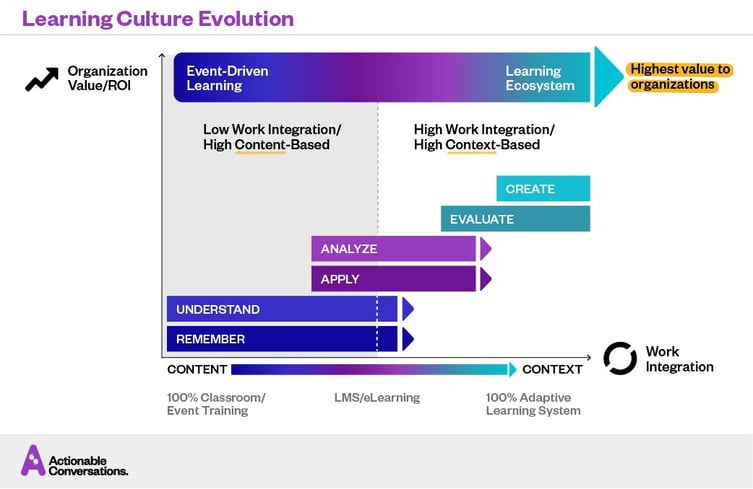As the workplace moves faster, Learning & Development leaders must keep up to ensure employees can adapt. High-impact learning is the answer to this. It is not only fast-paced, but it also involves strategies to increase retention rates, so your students aren’t just learning quickly, they’re able to retain and apply that knowledge.
A large part of a high-impact eLearning program’s success is that it involves people in leadership and management positions which help encourage and enforce learning. Results can be recorded and continual, leading to real changes in job performance.
Ensure you are creating high-impact eLearning courses. Check our key considerations that can deliver maximum returns on your eLearning investment.
1) Always Start With Why
To begin an eLearning program successfully, you have to consider why exactly are you starting it. Is there a problem that needs to be solved? Why do employees need this program? And what are the desired outcomes for the company and learners?
To assess the answer to these and identify needs within the organization, you need to look at what exists vs. what’s still needed (the gap). Some objectives for employees may already be outlined by the company’s human resources section and/or personal development plans. If these aren’t already available, you’ll have to assess training needs to find gaps in skills.
Understanding Your Audience: A big part of the “why” is about your audience and their needs. To understand them better, you need to take a close look at their skill gaps, their goals, motivations, where they are, and where they need to be.
An often-neglected part of audience analysis is understanding what they expect. What do your learners expect to gain from the course? If you don’t bother to learn this, you may find a group of disappointed and disillusioned learners who are unable to engage with the material.
When you understand your audience, you’ll be able to properly base your course on:
- Existing needs within the organization
- Addressing a skill gap or other problem
- Goals, and benefits to learners
Basing your course on these things is far more beneficial than creating learning for the sake of learning or trends. All too often companies will go to training first without ever considering if it’s the right option for accomplishing what is needed simply because that seems to be what everyone else is doing. Training that starts this way is almost always guaranteed to result in wasted time and resources.
Instead, you need to keep the above criteria in mind and keep desired outcomes in mind. If you’ve identified a skill that will help make jobs faster and easier, the result must be that employees now have this skill and it can be applied to the job with quantifiable results.
Also read: Want Your eLearning Courses to Deliver Results? Avoid These Mistakes
2) Align eLearning Goals with Business Objectives
It's also vital to reinforce what we’ve started in the first step by further aligning our learning goals with the company’s objectives and making sure they work together.
Your learning goals should be linked to an organizational need that has been identified as relevant and critical for the business or department.
For example, if there is new technology available and competency in that technology will allow your learners to do a component of their job faster, that could make training a valid option. However, if the job it would make faster isn’t important to the organization’s overall goals or needs, then you may need to step back and reconsider.
Read more: How to Design eLearning That Meets Business Goals
3) Learner Empowerment
Offering choices to your learners gives them the power to fuel their own learning journey and mold the way they consume content. Doing this is one of the cornerstones of what creates high-impact eLearning and sets it apart from other methods.
Giving learners the options to direct themselves will allow them to learn at their own pace, and learn what they need at the time they see fit to do so. They can customize their own experience and spend more time on the areas they feel they need to work on while wasting less time on areas they are doing well in. This makes the experience and the content more engaging, which also makes it stick better.
The autonomy this type of learning environment provides is appealing to a diverse workforce and takes into account differences in knowledge, experience, and educational background.
Must-reads:
Redefining Your L&D Strategy In Disruptive Times: Enter Self-Directed Learning
Here’s Everything You Need to Know About Self-Directed Learning at the Workplace
Here are some ways to empower your students:
- Give ongoing feedback to allow students to adjust as they go
- Create goals for learners and teams
- Make them feel safe to fail and learn from failure
- Allow for flexible scheduling and learning
Read more: The Rise of the Empowered Learner: 4 Things You Need to Know
4) Set Clear Goals For Your Learners
Your eLearning course isn’t a novel, and you shouldn’t be hiding the goals as if they’re a big reveal for the end. Goals should be made obvious to participants so they know what they’re working towards, what they should accomplish by the end, and how this helps them and the organization as a whole.
When developed properly, these goals will be the sturdy foundation of a useful, relevant eLearning course. You will be able to measure the success of the goals and identify exactly what should happen after training.
Make sure you have the support of your company's leadership, marketing, and other relevant groups to constantly reinforce why this learning is important.
5) Support Learning at Work
To reinforce the previous steps and make learning relevant and applicable in the workplace, we need to support learning objectives in the workplace. We do this by forming teams, encouraging interaction among learners, and making it an ongoing process where skills and knowledge are reapplied to the job at hand.
It’s also at this stage that we start to see a return on our design and investment. Learners are now seeing what their lessons mean for them and the company in real-time. By measuring success and evaluation results at this stage, we can tweak and mold the learning; keep what’s working, and change what isn’t.
Check out this graphic by Actionable Conversations where it illustrates how learning needs to go from Event-driven learning to a Learning Ecosystem, where knowledge happens by and within teams, integrated into their work, and in an ongoing process.

Also read: Why a Learning Culture Helps You Improve Your Company’s Bottom Line
6) Increase Engagement by Minimizing Barriers
Engagement translates to the retention and the ability to apply skills. Not surprisingly, this is a huge priority for the company and you as a course designer. Your job is to make engagement easier by making the content accessible and easy to use.
We reduce barriers to this engagement by ensuring we have proper support, tech, communication, and rewards laid out. Technology specifically must be used within the learning culture as a tool, not a distraction.
When used correctly, tech helps us manage to learn and creates a way to collaborate by allowing companies to interact and engage with employees on a regular, daily basis. By having this consistency, we reinforce the learning objective and the idea that the course material is relevant and necessary in the real world.
In essence, this collaboration allows students to add to the coursework. They interact with and learn from each other, ask questions and get answers, share relevant videos and experiences, etc. Most importantly, since this is available in a digital, mobile format, you can engage remote workers and allow people to learn when it works best for them. As a designer, instituting these self-learning options gives your audience the tools to make themselves and your course successful.
Must read: 5 Ways To Optimize Your eLearning Courses And Maximize Learner Engagement
With the right elements and strategy in place, Learning and Development leaders can shift from creating low-performing eLearning courses to high-impact ones.
REFERENCES:
10 Ways to Measure Learning Impact
High Impact Learning that Lasts
5 Steps to Designing High Impact Blended Learning Experiences
6 Key Principles of High Impact Learning



